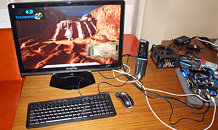Thursday, September 13th 2012

Lucid Demos Thunderbolt-based External Graphics for Ultrabooks
Ultrabooks, despite their formidable computing power compared to netbooks, inevitably trade some of it for lower thermal/power specifications. LucidLogix feels that Ultrabook users could gain graphics processing power on demand using external graphics cards, that work in tandem with its VirtuMVP GPU virtualization technology. At IDF, the company demonstrated an external graphics card that uses 10 Gb/s Thunderbolt interface to communicate with an Ultrabook.
Lucid's external graphics card is a Thunderbolt to PCI-Express enclosure, which runs an AMD Radeon HD 6700 series GPU. With the VirtuMVP layer running, the Ultrabook uses the graphics computing power of the external graphics card to render complex graphics onto its display, which is wired to the processor's integrated graphics core. Lucid's idea of on-demand graphics compute power allows Thunderbolt-equipped Ultrabooks of all shapes and sizes to lack a discrete GPU, which adds to the device's cost, and taps its limited power and thermal-control resources. At the moment, Lucid's external graphics cards are still in development, with no concrete release date in sight. The concept is solid.
Source:
LaptopMag
Lucid's external graphics card is a Thunderbolt to PCI-Express enclosure, which runs an AMD Radeon HD 6700 series GPU. With the VirtuMVP layer running, the Ultrabook uses the graphics computing power of the external graphics card to render complex graphics onto its display, which is wired to the processor's integrated graphics core. Lucid's idea of on-demand graphics compute power allows Thunderbolt-equipped Ultrabooks of all shapes and sizes to lack a discrete GPU, which adds to the device's cost, and taps its limited power and thermal-control resources. At the moment, Lucid's external graphics cards are still in development, with no concrete release date in sight. The concept is solid.

26 Comments on Lucid Demos Thunderbolt-based External Graphics for Ultrabooks
the video of the demo posted by the source should be useful
Sony Vaio Z had this capability, but gimped by shit graphics and sky high prices. Intel needs to make this a standard.
Asus had an external vga via express card, an 8600gt I guess.
So buying an adapter for the PC Card on the laptop will not work right?
this will allow thin, lightweight laptops on the go, with gaming performance when docked.
Hell, even that "Graceful Shutdown" sounds great. I would like to be able to flip a switch to turn on my 7970's when I wanna game or turn them off and rely on IGP for web browsing/netflix/productivity.
On a serious note how about building GPUs into screens and using ThunderBolt to connect?
How Ultra is this? Buy an overpriced thin machine with SSD + CPU only. Then have to buy tons of external drives, graphics, and storage just to be able to do things any regular laptop user can do. In the end, walk around with a suitcase full of accessories to an "Ultra" machine.
I say no. People deserve getting stuck with what they get if they buy into this craze. They'll never learn any other way.
now if you can buy any good laptop sub 800$ and simply keep a good CAD card in the thunderbold box. you can swap laptop at will and keep that card ... i like it.
They seem to scale, but at such a rate that it is barely relevant. (obviously this becomes relevant if the CPU scales towards impotency)
A bottleneck would be something I consider to be capped out until a certain point, then thereafter there are no further gains, meaning the bottleneck has been surpassed.
In these cases though, the CPU scaling does not stop, and miniscule FPS gains can be seen from the bottom, all the way to the top.
Thunderbolt adds additional latency.
ALWAYS. NEED. MORE.
even with a gaming grade laptop (AMD A6), its got GPU and CPU limitations. being able to OC the CPU and upgrade the GPU (via a dock) is a wet dream.
also, once GPGPU kicks off... well, any system you want can suddenly have upgraded performance just by docking it.